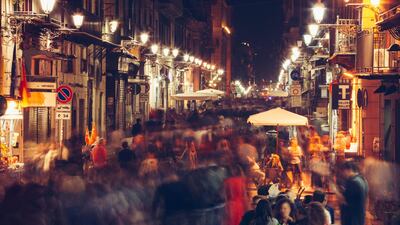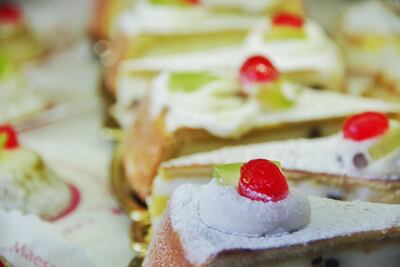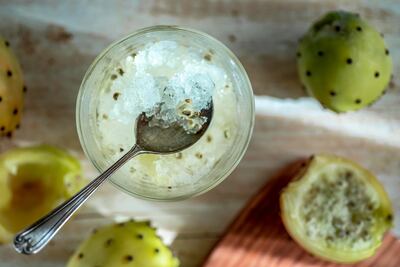“Palermo is among the top five international street-food destinations in the world – and the only one in Europe,” says Giorgio, our foodie tour guide, as we venture into a bustling Capo Market in the heart of the city’s historical district. Struggling to hear him over shouting vendors (“abbanitta” is the Sicilian term coined to describe their yelling), we’re plunged straight into dining with the locals.
Fruit and vegetables in a rainbow palette burst from every stall, a flashy reminder of the fertile land that has made Sicily the perfect spot for good old-fashioned, locally sourced ingredients. We approach a wisened old man selling frittola, a 500-year-old Palermitan snack of leftover pieces of veal that have been boiled, dried, then fried. He reaches into a sealed pot, careful not to let us in and any steam out. When the meat emerges from its dark, steamy confinement, the frittola tastes much better than it looks.
Next up is Palermo's infamous spleen sandwich. Not for the faint of heart, pani ca meusa, or cow spleen, is finely sliced before our eyes, sprinkled with cheese and wedged aggressively into a bread roll, before being thrust in our direction. My first bite is tentative; my second is not. Salty meat, melted cheese and bread – what's not to like?
Like many Palermitan dishes, the spleen sandwich is not native to Sicily. It was brought to the city more than 1,000 years ago by Jewish immigrants, who worked as butchers in the city and traded their skills for offal from the animals. "Sicily is at the centre of the Mediterranean world," explains Giorgio, who lists the Spanish, Byzantines, Normans, Phoenicians and Greeks as only some of the cultures that have permeated the island's history and food traditions.
Arancini, fried risotto balls traditionally filled with ragu, were actually an invention of the Arabs who came to Sicily many centuries ago. We dine on Palermo's best arancini at Touring Bar, surrounded by rowdy Sicilian families. I savour the different textures – first a crunchy fried layer, followed by dense rice, and a rich ragu lava that spills from the core of these hefty spheres.
Opposite Touring Bar is Bar Rosanero, a favourite of the Duchess of Palma, who lives at the end of the road in the stunning Palazzo, in which we are staying. She recommends we go there for a light panini lunch. I emerge having discovered and devoured my favourite dessert of all time, cassata Siciliana, a moistened sponge filled with sweet ricotta and marzipan, and topped with candied fruit. No other dessert can match this saccharine dream, served canteen-style by smartly dressed men in suits and ties.
The chaos of Sicily's multiethnic make-up has somehow worked its way into the style of service here. Canteen-style dining is popular, and despite being intimidating at first, it's an essential foodie experience.
Entering Focacceria del Massimo is like walking in on an Italian family argument. Chefs yell over boiling pots of pasta, customers walk in and out carrying precariously piled plates of spaghetti, and no one seems to know what they’re doing.
Pay €3 (Dh12), take a number and wait in line for the chef to take your order. Choose from five daily pastas, then slurp it up Lady-and-the-Tramp-style at a table in the street with a view of Europe's third largest opera house, the Massimo Theatre. Then it's on down the road to Caffe Spinnato for a creamy ricotta and chocolate-filled cannolo that cracks and crunches into a smooth, sugary abyss.
By night, we smarten up and dress for dinner. Carlo V in Palermo's atmospheric Piazza Bologni is a favourite of the Palermo football team. Fresh fish is the order of the day here and is best enjoyed at a table outside, surrounded by crumbling, bullet-hole-peppered buildings that call to mind Baz Luhrmann's Romeo + Juliet.
Sicily's dining scene extends to the Michelin-starred variety, with in-the-know locals frequenting the unassuming La Madia in Licata for its reinvention of nostalgic childhood favourites, or I Pupi in Bagheria.
Each course at I Pupi marries the flavours of Sicily with elegant food styling that verges on the architectural. Street food is taken out of context, miniaturised and served up on edible spikes, casting remarkable shadows across our crisp white table linen. A classic, pasta la norma, is reinvented as ravioli, delicately filled with buffalo and aubergine cream, and ricotta cheese. Dessert is lemon in four ways: cream, zest, cake and crumble.
Sicilians love their sugar-laden treats. Breakfast is basically a dessert of some sort, every day. My favourite is an almond and prickly pear granita (or sorbet) eaten with brioche and swilled down with a heart-pumping espresso at Bar Florio in Licata, a cosy, family-run spot that's been making artisanal granita since 1952. The blue-collar version of this is ice cream in a brioche (popular all over Sicily and terrifying on first inspection), the best of which we eat at Latte Pa on Mondello Beach while soaking up the sun.



